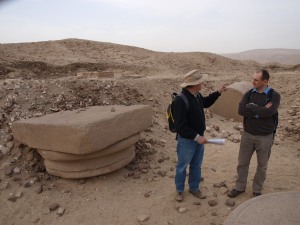End of first phase of magnetometry – and a day off
Second blog of the day trying to catch up on over a week of missed writing. For the last four days the magnetometry has been continuing in the necropolis area of Antinoupolis. Work starts on site at 7am sharp, and we take a knackered old pick-up truck on a track roughly along the line of one of the decumani of the city, out to the Severian wall and up to the Coptic chapel of Theodosia adjacent to the Roman necropolis.
For the last few days the sounds of wolves baying higher up the wadis and around the many quarries overlooking the necropolis has greeted us. At least two packs, one to the the north and the other to the east compete with each other. In addition Abu Hussein has made an appearance twice in the last week. The first time slinking off up to the heights above the site, and the second padding across the wadi down towardss the Roman city, before he spotted the geophysics team and retreated to the wadi.
By today around 10 hectares of magnetometry has been conducted, some over the areas of Gayets excavations, and some in areas that appear untouched. Thoussands of anomalies appear in the results, and the process of interpretation will be time-consuming. However the fieldwork is moving forward, and after a day off today the team will be working in the area of the ancient city, around the northern sector of the walled area.
Two things are striking about t he archaeology of the city. The first is the massive scale of some of the architectural fragments located around the site, comprising columns, basins, pavements and other features.
The nature of the architectural fragments, in limestone and granite, together with the fired and mud-brick material, suggest that the magnetometry should provide some useful results in the coming days.
The second striking feature of the city is the scale and quantity of disturbed structures and the shifting mountains of fired brick.
Whereas some of the areas of the city provide optimal conditions for the survey, a large proportion of the walled area is covered by this rubble. Some of it is on a massive scale, rising three or four storeys from the surrounding remains, with odd columns from the decumani and caromaximus poking through the material. The difficulty here for the team in the future is going to be finding the most appropriate method for survey of these areas. Magnetometry is pretty ineffective, in fact it can be dangerous. We may have to look at surveying some target areas using GPR, taking the profiles incredibly slowly. What is undisputed is the massive scale of the structures and materials that went in to the construction of Antinoupolis. Tomorrow more magnetometry in the city, but now time for some rest.



